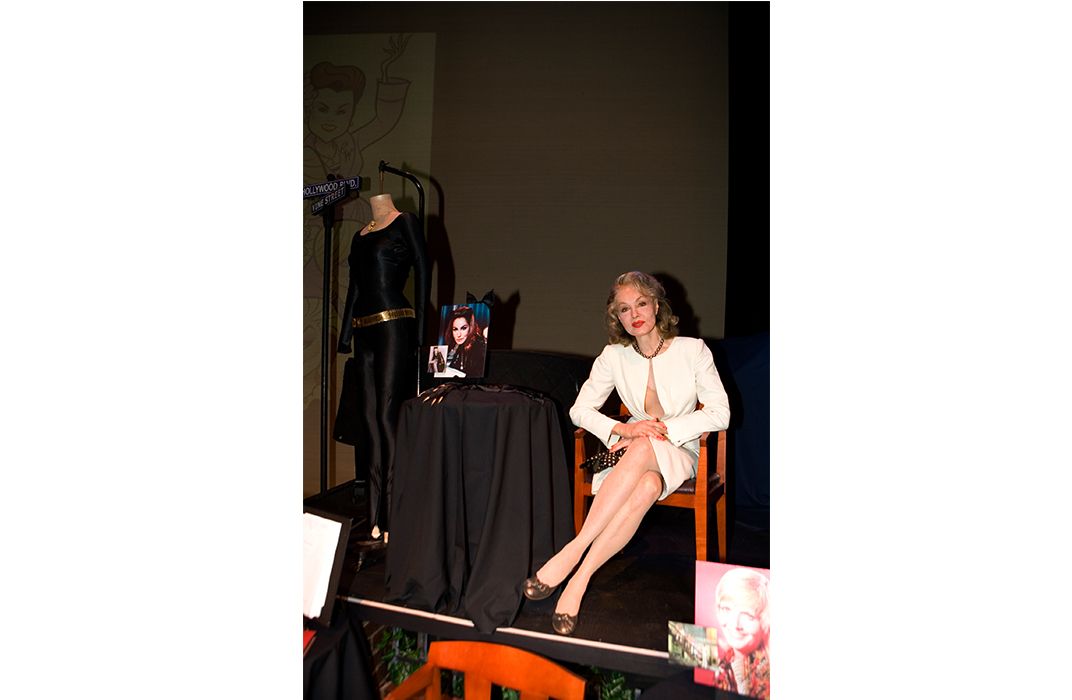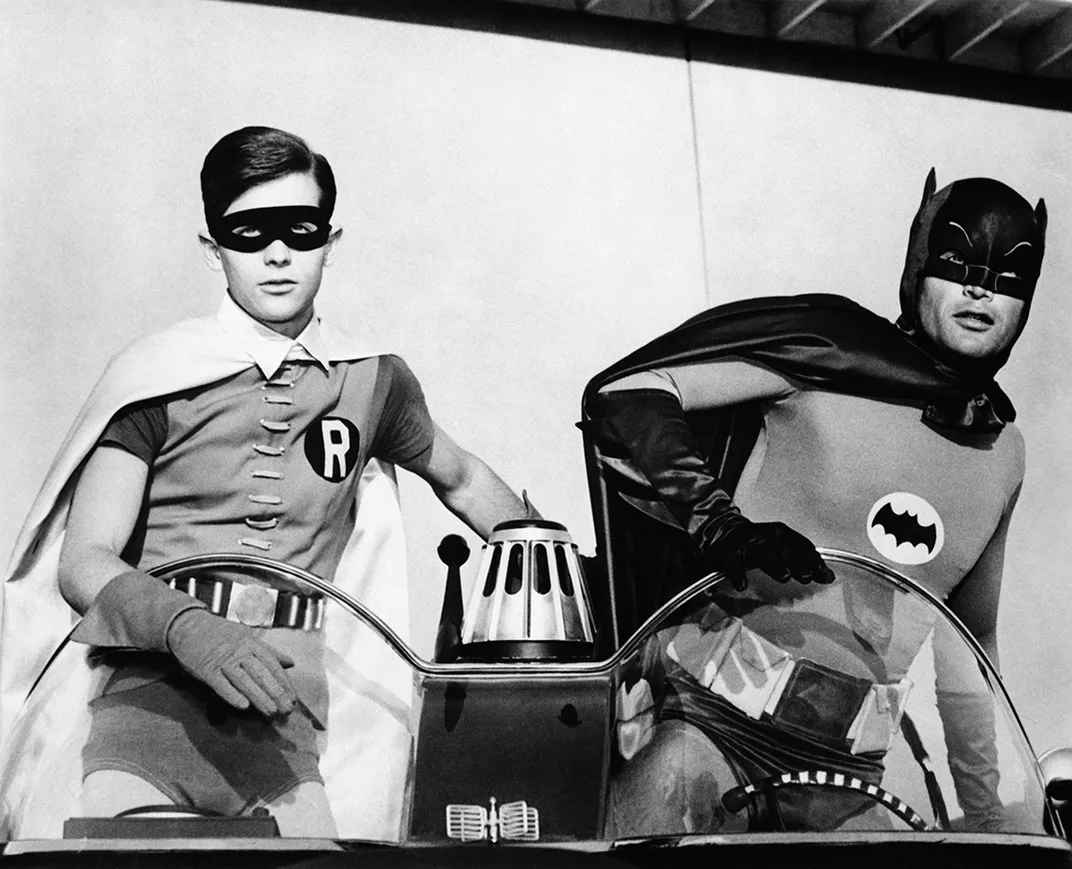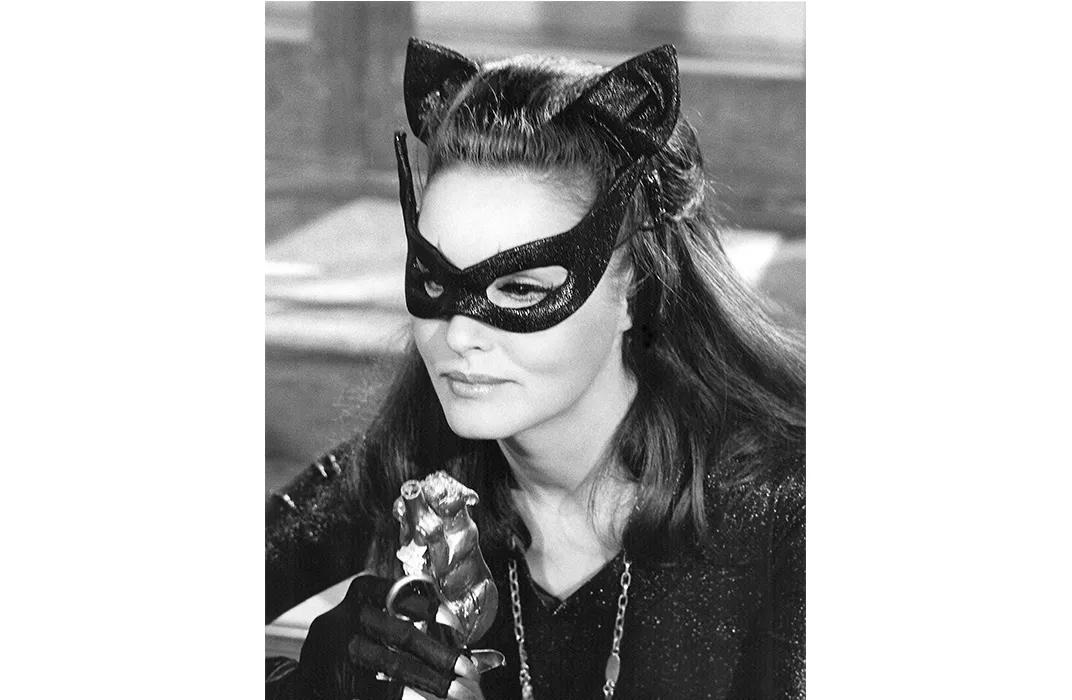When Batman Went “Bam!” and “Pow”
The original Catwoman, Julie Newmar recalls fitting into that distinctive costume—now at the Smithsonian
:focal(454x132:455x133)/https://tf-cmsv2-smithsonianmag-media.s3.amazonaws.com/filer/50/1f/501fbab7-737d-4a51-a665-4ecb4fd57509/jn-catwomanweb.jpg)
Holy time passage! January 12 marks the anniversary of the start of the “Batman” TV show in 1966.
The colorful tongue-in-cheek superhero romp, initially aired twice a week, became a quick sensation, with its arch, campy tone, its “POW!” and “BLAM!” fight cards seem lifted from pop art, and na-na-na-na theme song.
“Batman” lasted just three years and yielded 120 episodes. But it created a whole new generation of fans for the crime solving comic book hero first devised in 1939, long before he became a much darker figure in big screen blockbusters (who indeed will return March 25 in Batman v Superman: Dawn of Justice).
The classic show’s Batman and Robin, as portrayed by Adam West and Burt Ward, are still strong draws at comic book conventions on the nostalgia circuit. And as the only other surviving member of the cast, Julie Newmar, donated her shapely Catwoman costume to the Smithsonian eight years ago.
It has been displayed in a glass case on the third floor of the Museum of American History in Washington, as one of the “National Treasures of Popular Culture,” among such artifacts as the original Kermit the Frog, Archie Bunker’s chair and Eddie Van Halen’s guitar.

“It’s my bragging point, are you kidding?” says Newmar, still a purr in her voice at 82.
The distinctive black outfit, with topping ears, was made just for her, and clung to her frame. “I believe the material was called Lurex,” she says in an interview from Los Angeles. “It was woven in two different directions—one has this reflective, shiny blue midnight that catches the light for the cameras, and the other was a black semi stretch, although I can recall some wrinkles,” she adds with a laugh.
Newmar put in a few alterations herself.
“I put the gold belt around the hips,” she says, “because at the waist it enlarges the waist, and if you put it at the hips, it gives you that curvier look. That and the inside seams were sewn to my specifications.”
And it was a tall order. At 5’11”, “it’s a long way to the floor, let’s put it that way,” the actress says of her stance. “And then you put on heels and you get a little dizzy up here.”
Eddie Cantor called hers “the most beautiful legs in the Follies” when the dancer began her career in the Ziegfeld Follies.
By the mid-1960s, Newmar was already known for some sultry roles on stage, from one of the brides in Seven Brides for Seven Brothers and as Stupefyin’ Jones in Li’l Abner on stage and screen.
She made her mark on TV as “The Living Doll” in 1964 and ’65.

“It was the difficult part of a robot,” Newmar says. “It was a golden opportunity for an actress to do so much. I danced ballet, I played the piano, I was a crack pool artist; whatever they could write for me, I had the opportunity to do. So I think the greater the challenge, the more, at least looking back on it, that we say we love that part most. “
But she’s known by far the best for her role as Catwoman. “I’ve been told many times it was my brother who induced me to take on this part, since I was living in New York,” Newmar says. “He came over to visit with five or six his Harvard friends and he overheard a phone call that I had gotten, producers asking me to fly out.
“I guess they had run out of actresses. At the last minute, on the weekend, I flew out; on a Monday, I got the script and the costume fitting. I think we were working by Wednesday. It was that quick. That’s how television works.”
The role itself wasn’t necessarily athletic. “ It was more slink around, you might say,” Newmar says.
But she certainly got to use her dance skills.
“There was as much dance in that role as there was acting,” she says. “It was highly physicalized. And yet in a subtle way. You didn’t want to say, here’s the dancer. I think Yvonne Craig did that when she did her high kicks as Batgirl. But all that movement has to be true to character.”
Newmar says she was never particularly a fan of the Batman comic books (“I was a Brenda Starr fan”), but soon found herself tied to the role that was later played by Eartha Kitt in the third and final season of “Batman” and by Lee Meriwether in the 1966 Batman movie.
“That is the memory that people attach to me, Catwoman,” Newmar says. “And it just keeps on growing.There’s something about this story in particular that all ages seem to hook into and identify with.”

And while female superheroes are more common on television today, she was something of a groundbreaker in 1966. Indeed, there weren’t many women on TV at the time who were empowered as all.
“Young girls will come up to me and say, ‘Oh, your character gave me hope in life that I could be a strong and forthright female.’ And that was a surprise to me,” Newmar says. “I think women have come forth to a great degree since then.”
For all the impact she may have made, she was only in six one-hour episodes of “Batman” all told. And she wasn’t in the third season at all.
“It was quite costly,” Newmar says of the production of the show. “And they brought in “The Green Hornet,” thinking that would be a huge hit. They should have stuck with ‘Batman.’”
Others have gone on to play Catwoman in their own custom Catwoman suits. Michelle Pfeiffer took the role in the 1992 film Batman Returns. Halle Berry had the lead role in the 2004 movie Catwoman. Anne Hathaway had the role in the 2012 The Dark Knight Rises and currently Camren Bicondova plays an early version of Catwoman on the Fox television series “Gotham.”
“It’s a marvelous role,” Newmar says. “There would be many women to play that role, and each of them will give the role something inimitable and marvelous and new. It’s just like ‘Aida’ or ‘Carmen’ or one of the great opera roles. There will be many interpretations.”
The jumpsuit was donated in 2008 by alongside eight other gifts that included Angela Lansbury’s costume from Mame, Carol Channing’s diamond dress from Lorelei, Tippi Hedren’s script for The Birds, Esther Williams’ scrapbooks, and awards won by Florence Henderson and June Lockhart.
According to Stacey Kluck, chair and curator in the museum’s division of culture and the arts, the Catwoman suit is not currently on display, it’s headed to the conservation lab to preserve it for the centuries to come.
But Newmar may one day don a Catwoman costume once more, with talks of a 50th anniversary sequel featuring Batman and Catwoman. “But I’m not supposed to talk about it.”
UPDATE 1/12/2016: A previous version of this article inaccurately reported the number of seasons that the show appeared on television. "Batman" ran for three seasons from 1966 to 1968.
/https://tf-cmsv2-smithsonianmag-media.s3.amazonaws.com/accounts/headshot/RogerCatlin_thumbnail.png)


/https://tf-cmsv2-smithsonianmag-media.s3.amazonaws.com/accounts/headshot/RogerCatlin_thumbnail.png)